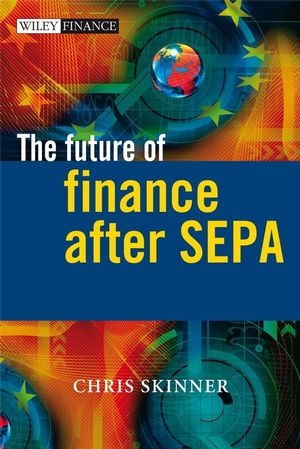
The Future of Finance after SEPA
John Wiley & Sons Inc (Verlag)
978-0-470-98782-7 (ISBN)
SEPA was created by Europe’s banks in 2002 in response to regulations and plans drawn up by the European Commission from a meeting in Lisbon at the turn of the millennium. Consequently, SEPA has been assisted by new legislation, the PSD, which was agreed in 2007. The implementation of SEPA takes place in 2008 within the banking industry, with full operation in 2010, and will be a massive change to not just banking, but all aspects of finance and financial services across Europe and the globe. This is because the vision for SEPA is that, by 2010, all euro payments are treated in the same way as domestic payments. In other words, European citizens and corporations enjoy a transparent market where there is no difference in charges for payments between Rome, Madrid, Paris and Munich. As a result, citizens, governments and corporations will have full access to finance transparently across 15 countries today and potentially 31 tomorrow. A United States of Europe, fuelled by fully integrated financing, will be different to the fragmented Europe of the past.
This book reviews the key implications and challenges of SEPA and the PSD across the European landscape, and the likely outcomes of SEPA for 2010 and beyond. The main themes that emerge are that many of Europe’s leading providers of payments infrastructures, which are often bankowned, will disappear and new payments providers and structures will emerge. Some of these will be evolutions and some will be revolutions. In addition, there will be major impacts upon those banks that cannot provide euro-services competitively in this new geographically competitive environment. The winners will reap major rewards, but there will be far more losers who will be merged or acquired.
With contributions from leading authorities, including:
• Anthony Kirby, the Reference Data User Group
• Ashley Dowson, the SEPA Consultancy
• Bo Harald, TietoEnator
• Bodil Nelsson and Mats Wallén, Bankgirocentralen
• Brenda O’Connell, Bank of Ireland
• Chris Pickles, BT
• Chris Skinner, the Financial Services Club and Balatro
• Daniel Szmukler, EBA CLEARING
• Daniele Danese, Banca Popolare di Verona
• David Doyle, EU Policy Advisor on Financial Markets
• Doctor John Ryan, CASS Business School
• Erkki Poutiainen, Nordea
• Eva King, the European Commission
• Geoffroy de Schrevel, SWIFT
• Gerard Hartsink, the European Payments Council
• Gianfranco Tabasso, the European Association of Corporate Treasurers
• Harry Leinonen, the Bank of Finland
• Heiko Schmiedel, the European Central Bank
• Henrik Parl, Eurogiro
• Hervé Postic, founder, UTSIT
• James Barclay, JPMorgan Chase
• John Bullard, IdenTrust
• John Chaplin, First Data
• Jonathan Williams, Eiger
• Juergen Weiss, Gartner
• Mark Hale, Barclays Bank
• Neil Burton, IBM
• Nick Senechal, VocaLink
• René Pelegero, PayPal
• Richard Spong, Sterling Commerce
• Robert Bradfield, Ernst & Young
• Ruth Wandhöfer, Citi
• Sean Fitzgerald, Sentinel
• Sharon Bowles, Member of the European Parliament
• Tom Buschman, TWIST
CHRIS SKINNER is known worldwide as a leading commentator and strategist on the financial markets. He works full-time as the Chief Executive of the think tank Balatro, as well as being the Chairman of the Financial Services Club and a co-founder of the website Shaping Tomorrow. He writes a regular column in the Banker magazine, and blogs on theFinanSer and Finextra. Chris is a regular key note speaker at the world’s largest financial services conferences including SWIFT’s SIBOS, BAI, IIR and the Financial Times and the author of several other books published by John Wiley, including "The Future of banking in a globalised world" and "The Future of investing in Europe’s markets after MiFID".
About the Editor About the Contributors
Preface.
Acknowledgements.
An Introduction to SEPA (Chris Skinner).
PART 1: THE VIEWS OF THE ARCHITECTS.
1. The EPC and the Single Euro Payments Area (SEPA): It’s now up to the banks and their customers! (Gerard Hartsink, the EPC).
2. The economic impact of SEPA on Europe’s banks (Heiko Schmiedel, the European Central Bank).
3. The vision of a Single European Payments Market (Eva King, the European Commission).
4. Creating the Payment Services Directive for SEPA (Sharon Bowles, Member of the European Parliament).
PART 2: THE VIEWS OF THE PAYMENT PROCESSORS.
5. Was SEPA worth the effort after all? (Geoffroy de Schrevel, SWIFT).
6. Europe’s future payments infrastructures (Daniel Szmukler, EBA CLEARING).
7. Bilateral clearing likely to be dominant clearing method in SEPA (Henrik Parl, Eurogiro).
8. Is listening to the regulator enough? (Nick Senechal, VocaLink).
9. The implications of SEPA to the Nordics (Bodil Nelsson and Mats Wallén, Bankgirocentralen BGC AB, Sweden).
10. Eight Predictions for SEPA’s Impact on Payment Cards (John Chaplin, First Data).
11. SEPA and eCommerce – the Consumer is King (René Pelegero, PayPal).
PART 3: THE VIEWS OF THE BANKS.
12. The Payment Services Directive – a critical review (Ruth Wandhöfer, Citi).
13. SEPA – The Implications for banks (Mark Hale, Barclays Bank).
14. Bring on the benefits, a SEPA success story (James Barclay, JPMorgan Chase).
15. The Impact of SEPA on the Irish Payments Industry (Brenda O’Connell, Bank of Ireland).
16. After 2010: Will the customer become King (Harry Leinonen, the Bank of Finland).
17. The implications of SEPA for e-invoicing (Erkki Poutiainen, Nordea).
18. Banking after SEPA: 2010 and beyond (Daniele Danese, Banca Popolare di Verona).
PART 4: THE VIEWS OF THE CORPORATES.
19. SEPA: an introduction for corporates (John Ryan, CASS Business School).
20. SEPA: The Corporate Perspective (Gianfranco Tabasso, EACT and Tom Buschman, TWIST).
PART 5: THE VIEWS OF THE OBSERVERS OF SEPA.
21. Will the promises of SEPA come true for corporates? (Juergen Weiss, Gartner).
22. The Single European Payments Area – the user and supplier perspectives (David Doyle, EU Policy Advisor on Financial Markets).
23. SEPA – It’s Trench Warefare (Ashley Dowson, the SEPA Consultancy).
24. Payments Operations – Building to protect the franchise (Robert Bradfield, Ernst & Young).
25. SWIFT for Corporates, a channel to SEPA (Hervé Postic, founder, UTSIT Paris).
PART 6: THE VIEW OF THE IMPLEMENTERS OF SEPA.
26. The most critical technologies for SEPA (Neil Burton, IBM).
27. Compliance: Friend or Foe? (Sean Fitzgerald, Sentenial).
28. SEPA: How the technology requirements for SEPA will help it evolve (Jonathan Williams, Eiger).
29. The relationship between SEPA and Anti-Money Laundering (AML)(Anthony Kirby, Chair Reference Data Subject Group and Member of the Executive Committee, ISITC).
30. SEPA and identity: are you who you say you are, and does it matter? (John Bullard, IdenTrust).
31. Why SEPA needs e-invoicing (Bo Harald, TietoEnator).
32. The Technology Standards required for SEPA (Chris Pickles, BT).
33. The most critical technologies for SEPA (Richard Spong, Sterling Commerce).
Appendix - Useful Resources.
Glossary of Terms.
Index
| Erscheint lt. Verlag | 4.4.2008 |
|---|---|
| Reihe/Serie | Wiley Finance Series |
| Verlagsort | New York |
| Sprache | englisch |
| Maße | 175 x 252 mm |
| Gewicht | 771 g |
| Themenwelt | Wirtschaft ► Betriebswirtschaft / Management ► Finanzierung |
| Betriebswirtschaft / Management ► Spezielle Betriebswirtschaftslehre ► Bankbetriebslehre | |
| ISBN-10 | 0-470-98782-0 / 0470987820 |
| ISBN-13 | 978-0-470-98782-7 / 9780470987827 |
| Zustand | Neuware |
| Haben Sie eine Frage zum Produkt? |
aus dem Bereich


